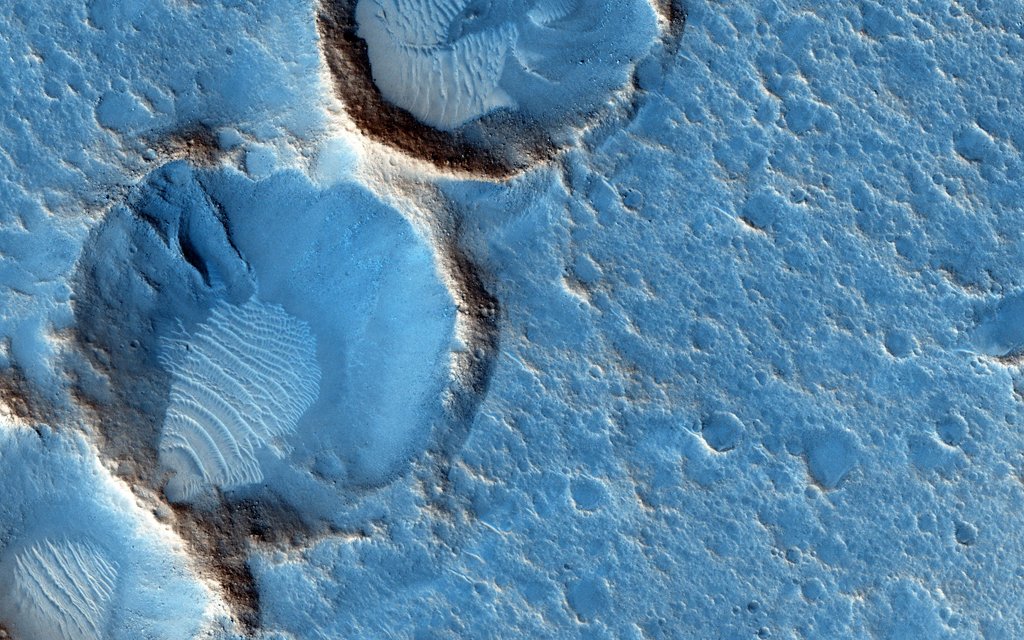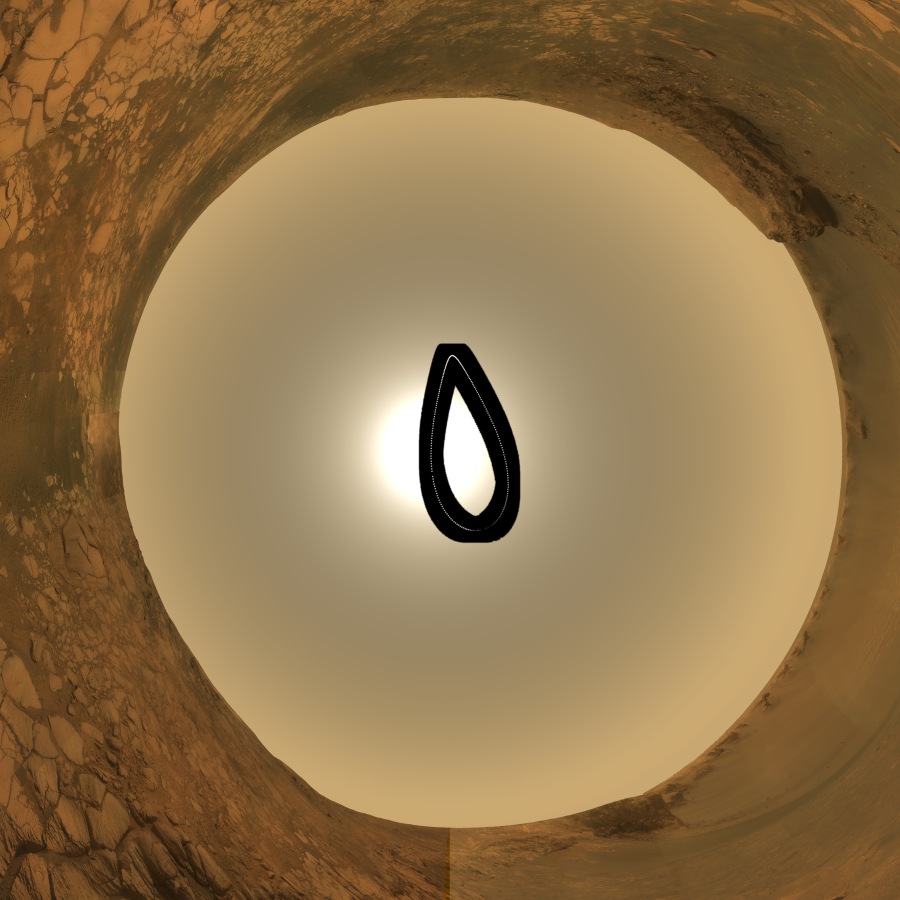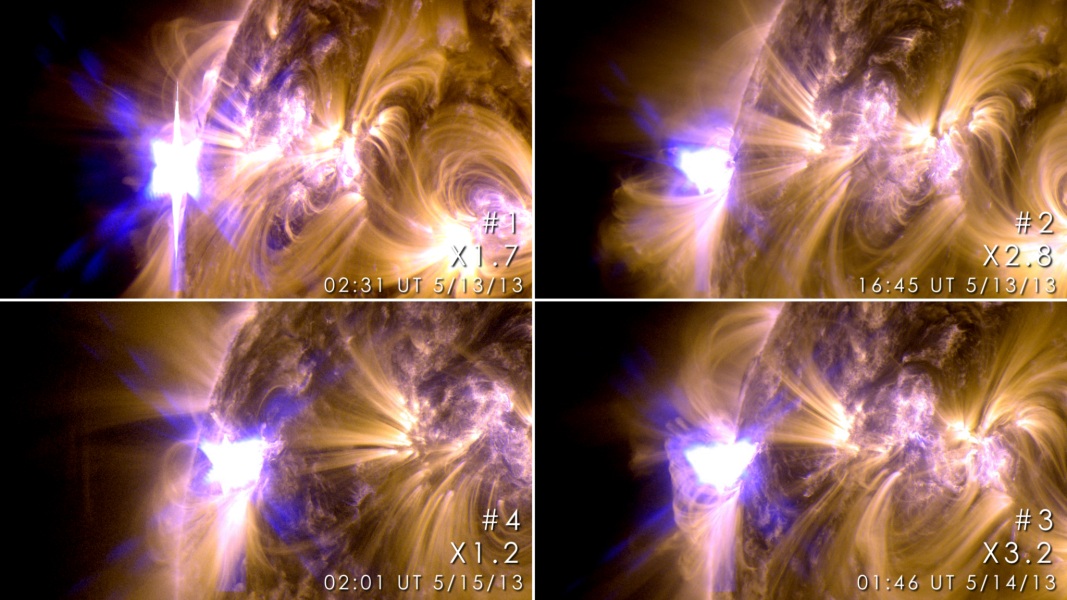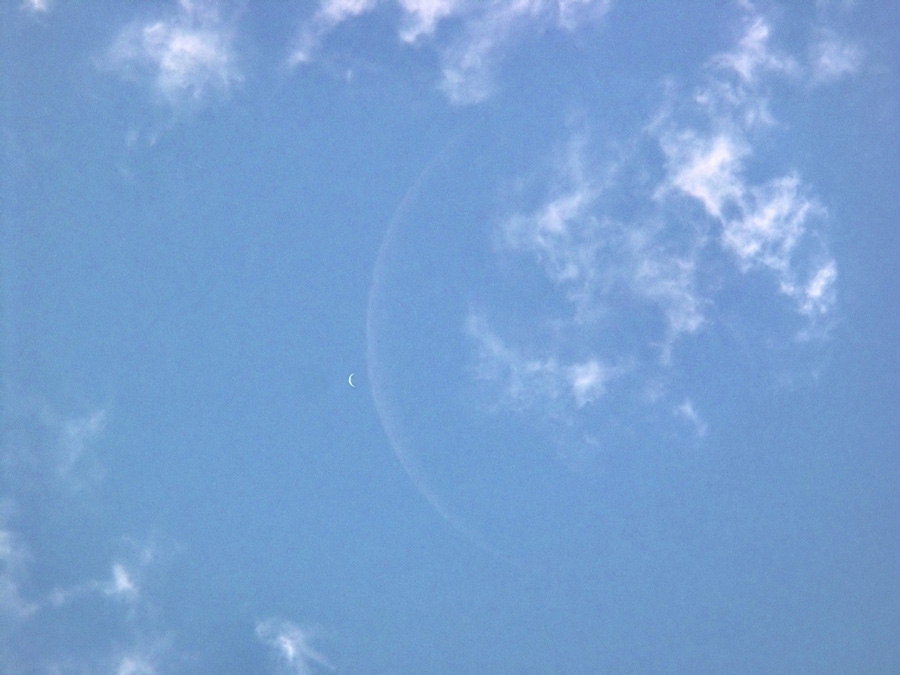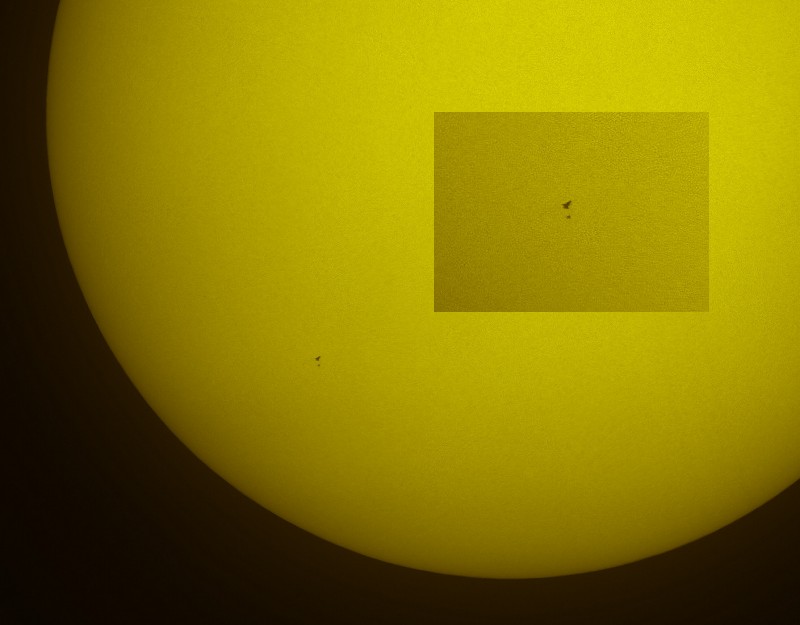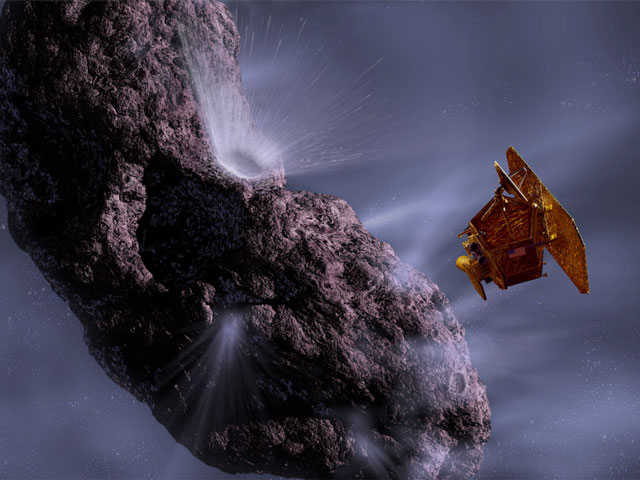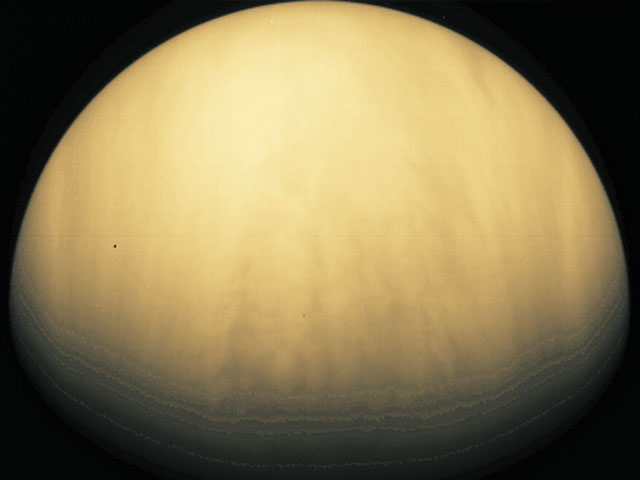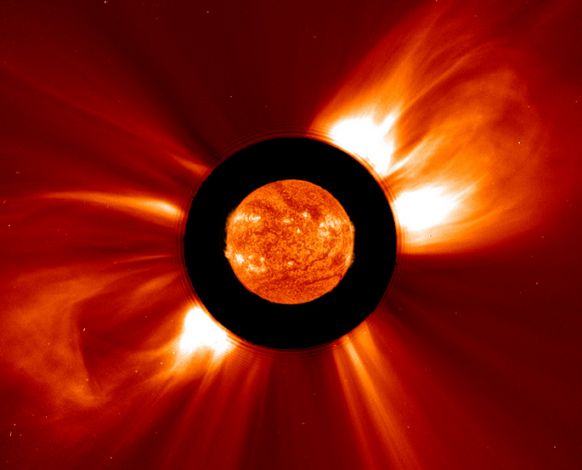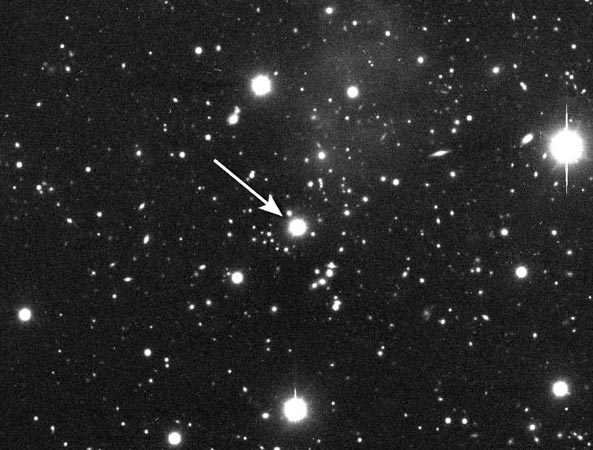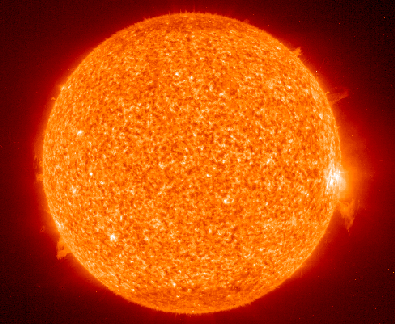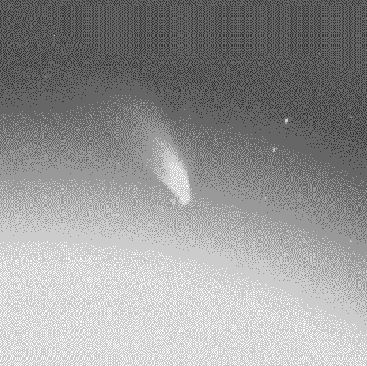| << Previous | Index | Next >> |
2015 This close-up from the Mars Reconnaissance Orbiter's HiRISE camera shows weathered craters and windblown deposits in southern Acidalia Planitia. A striking shade of blue in standard HiRISE image colors, to the human eye the area would probably look grey or a little reddish. But human eyes have not gazed across this terrain, unless you count the eyes of NASA astronauts in the scifi novel The Martian by Andy Weir. The novel chronicles the adventures of Mark Watney, an astronaut stranded at the fictional Mars mission Ares 3 landing site corresponding to the coordinates of this cropped HiRISE frame. For scale Watney's 6-meter-diameter habitat at the site would be about 1/10th the diameter of the large crater. Of course, the Ares 3 landing coordinates are only about 800 kilometers north of the (real life) Carl Sagan Memorial Station, the 1997 Pathfinder landing site.
2014 Staring up into the martian sky, the Opportunity rover captured an image at 11:02 AM local mean time nearly every 3rd sol, or martian day, for 1 martian year. Of course, the result is this martian analemma, a curve tracing the Sun's motion through the sky in the course of a year (668 sols) on the Red Planet. Spanning Earth dates from July, 16, 2006 to June 2, 2008 the images are shown composited in this zenith-centered, fisheye projection. North is at the top surrounded by a panoramic sky and landscape made in late 2007 from inside Victoria crater. The tinted martian sky is blacked out around the analemma images to clearly show the Sun's positions. Unlike Earth's figure-8-shaped analemma, Mars' analemma is pear-shaped, because of its similar axial tilt but more elliptical orbit. When Mars is farther from the Sun, the Sun progresses slowly in the martian sky creating the pointy top of the curve. When close to the Sun and moving quickly, the apparent solar motion is stretched into the rounded bottom. For several sols some of the frames are missing due to rover operations and dust storms.
2013 Swinging around the Sun's eastern limb on Monday, a group of sunspots labeled active region AR1748 has produced the first four X-class solar flares of 2013 in less than 48 hours. In time sequence clockwise from the top left, flashes from the four were captured in extreme ultraviolet images from the Solar Dynamics Observatory. Ranked according to their peak brightness in X-rays, X-class flares are the most powerful class and are frequently accompanied by coronal mass ejections (CMEs), massive clouds of high energy plasma launched into space. But CMEs from the first three flares were not Earth-directed, while one associated with the fourth flare may deliver a glancing blow to the Earth's magnetic field on May 18. Also causing temporary radio blackouts, AR1748 is likely not finished. Still forecast to have a significant chance of producing strong flares, the active region is rotating into more direct view across the Sun's nearside.
2012
2011
Credit & Copyright: Daniel López, IAC; Music: Matti Paalanen, Angel's Tear (Aeon 2)
2010 There's something behind these clouds. Those faint graceful arcs, upon inspection, are actually far, far in the distance. They are the Earth's Moon and the planet Venus. Both the Moon and Venus are bright enough to be seen during the day, and both are quite capable of showing a crescent phase. To see Venus, which appears quite small, in a crescent phase requires binoculars or a telescope. In the above dramatic daytime image taken from Budapest, Hungary in 2004, the Moon and Venus shared a similar crescent phase a few minutes before the Moon eclipsed the larger but more distant world. Similarly, visible today in parts of Africa and Asia, a crescent Moon will again eclipse Venus during the day. About an hour after the above image was taken, Venus reappeared.
2009 On Wednesday, May 13, two, tiny, fast moving spots crossed an otherwise featureless solar disk. Not sunspots though, the dark blemishes were silhouettes of the shuttle orbiter Atlantis and the Hubble Space Telescope side by side. To record this sharp picture of the orbiting pair against the face of the Sun, astronomer Thierry Legault carefully set up his camera and telescope near the center of a 5 kilometer wide path of visibility about 100 kilometers south of Kennedy Space Center in Florida. He opened the shutter for 1/8,000 second at 12:17 EDT, catching Atlantis and Hubble at a range of 600 kilometers while they were moving at 7 kilometers/second. The total duration of the transit (Sun crossing) was 0.8 seconds. Enlarged in the inset view, Atlantis (top) is approaching Hubble prior to capturing the space telescope. Thursday, astronauts began a series of spacewalks to perform the maintenance as part of the final mission to Hubble.
2008 Gazing skyward on a sunny day in May, photographer Jean-Marc Lecleire captured this engaging display of ice halos forming complete circles in the sky. Recorded with a fish-eye lens from a spot near the grand Château de Chambord in France, the picture looks straight up, spanning almost 180 degrees from horizon to horizon. Surrounding the Sun is a halo formed by sunlight refracting through hexagonal-shaped ice crystals in high, thin clouds. The halo is circular and exactly 22 degrees in radius, but it looks squashed because of the distortion of the extremely wide-angle lens. Surrounding the zenith (the point directly above the observer) and always at the same altitude as the Sun is a lovely parhelic circle, caused by sunlight reflecting from ice crystals with nearly vertical faces. On average more common than rainbows, beautiful ice halos can often be seen in planet Earth's sky by those who know how to look for them.
2007 How do we know that dark matter isn't just normal matter exhibiting strange gravity? A new observation of gravitationally magnified faint galaxies far in the distance behind a massive cluster of galaxies is shedding new dark on the subject. The above detailed image from the Hubble Space Telescope indicates that a huge ring of dark matter likely exists surrounding the center of CL0024+17 that has no normal matter counterpart. What is visible in the above image, first and foremost, are many spectacular galaxies that are part of CL0024+17 itself, typically appearing tan in color. Next, a close inspection of the cluster center shows several unusual and repeated galaxy shapes, typically more blue. These are multiple images of a few distant galaxies, showing that the cluster is a strong gravitational lens. It is the relatively weak distortions of the many distant faint blue galaxies all over the image, however, that indicates the existence of the dark matter ring. The computationally modeled dark matter ring spans about five million light years and been digitally superimposed to the image in diffuse blue. A hypothesis for the formation of the huge dark matter ring holds that it is a transient feature formed when galaxy cluster CL0024+17 collided with another cluster of galaxies about one billion years ago, leaving a ring similar to when a rock is thrown in a pond.
2006 The International Space Station (ISS) is the largest human-made object ever to orbit the Earth. Last August, the station was visited and resupplied by space shuttle Discovery. The ISS is currently operated by the Expedition 13 crew, consisting a Russian and an American astronaut. After departing the ISS, the crew of Discovery captured this spectacular vista of the orbiting space city high above the Caspian Sea. Visible components include modules, trusses, and expansive solar arrays that gather sunlight that is turned into needed electricity.
2005 What happens when you crash into a comet? That was a question considered by astronomers when they designed the Deep Impact mission, launched in January. This coming July 4, the Deep Impact spaceship will reach its target - Comet Tempel 1 -- and release an impactor over five times the mass of a person toward its surface. The mothership will photograph the result. The remaining crater may tell how Tempel 1 is constructed. If, for example, Comet Tempel 1 is an extremely loose pile of debris, the impactor may leave little or no discernable crater. On the other hand, if the comet's surface is relatively firm, the impactor's ripple may leave quite a large crater. A contest is even being held to predict the size of the resulting crater. Pictured above is an artist's impression of the initial encounter between the spacecraft and the comet.
2004 This picture by the Galileo spacecraft shows just how cloudy Venus is. Venus is very similar to Earth in size and mass - and so is sometimes referred to as Earth's sister planet - but Venus has a quite different climate. Venus' thick clouds and closeness to the Sun (only Mercury is closer) make it the hottest planet - much hotter than the Earth. Humans could not survive there, and no life of any sort has ever been found. When Venus is visible it is usually the brightest object in the sky after the Sun and the Moon. More than 20 spacecraft have visited Venus including Venera 9, which landed on the surface, and Magellan, which used radar to peer through the clouds and make a map of the surface. This visible light picture of Venus was taken by the Galileo spacecraft that orbited Jupiter from 1995 to 2003. Many things about Venus remain unknown, including the cause of mysterious bursts of radio waves.
2003 This colorful telescopic view towards the northern constellation Lyra reveals dim outer regions around M57, popularly known as the Ring Nebula. While modern astronomers still refer to M57 as a planetary nebula, at one light-year across M57 is not a planet but the gaseous shroud of a dying sun-like star. Roughly the same apparent size as M57, the fainter, often overlooked barred spiral galaxy IC1296 is at the lower right and would have been referred to in the early 20th century as a spiral nebula. By chance the pair are in the same field of view, and while they appear to have similar sizes they are actually very far apart. M57 lies at a distance of a mere 2,000 light-years, well within our own Milky Way galaxy. Extragalactic IC1296 is more like 200,000,000 light-years distant or about 100,000 times farther away. Since they appear roughly similar in size, spiral nebula IC1296 must also be about 100,000 times larger than planetary nebula M57.
2002 During April and May, attention has been focused on the western evening sky, presenting its spectacle of bright planets and crescent moons shortly after sunset. Meanwhile, the the Sun itself has not been just sinking quietly below the horizon. For example on May 2nd, two enormous clouds of energetic particles blasted away from the solar surface in nearly simultaneous eruptions. Known as coronal mass ejections (CMEs), they appear as large "bubbles" oriented at about 2 o'clock and 8 o'clock in this composite image from cameras onboard the sun-staring SOHO spacecraft. At picture center, an extreme ultraviolet image of the Sun recorded near the time of these eruptions has been superimposed for scale. The blank region surrounding it corresponds to an occulting disk in one of SOHO's coronagraphic cameras. Speeding outward at millions of kilometers per hour, these two CMEs missed our fair planet. But those that do impact Earth's magnetosphere often trigger auroral displays and disruptions.
2001 Are black holes the cause of X-rays that pour out from the center of the Circinus galaxy? A new high-resolution image from the orbiting Chandra X-ray Observatory has resolved the inner regions of this nearby galaxy into several smaller sources. The image is shown above in representative-color. Extended X-ray emission from the center appears to match optical light and appears consistent with a model where hot gas is escaping from a supermassive black hole at Circinus' center. At least one of the other sources varies its X-ray brightness as expected from a binary star system, indicating that the system is small yet massive, and giving credence to a model where a black hole is surrounded by doughnut-shaped ring. The region shown spans about 5000 light-years across.
2000 A quasar slightly depleted of a specific color of light may indicate that our universe is filled with massive amounts of ionized hydrogen. Light from QSO H1821+643, pictured above, comes to us from about a quarter of the way across the visible universe. Detailed analysis now indicates that a tiny amount of this quasar's light was absorbed by intervening ionized oxygen. Astronomers intuit that this oxygen is surely accompanied by much more abundant ionized hydrogen, which would otherwise be invisible. The oxygen is thus thought to be the tip of a tremendous iceberg, indicating a universe filled with proton and electron clouds so vast they likely exceed the mass of all the stars combined. Still, this is only a small part of the long-sought dark matter astronomers have been searching for. Our universe is thought to be filled with much more abundant, much stranger forms of dark matter.
1999 This is what Europe looks like at night! Can you find your favorite European city? Although not all of Europe is shown, city lights might make this task possible. The above picture is actually a composite of over 200 images made by satellites orbiting the Earth. Scans were made by the USAF Defense Meteorological Satellite Program (DMSP) Operational Linescan System. The DMSP satellites continue to help in the understanding and prediction of weather phenomena as well as provide key information about population patterns, city light levels, and even rural forest fires.
1998 This image of the relatively quiet Sun was made using ultraviolet light emitted by ionized Helium atoms in the Solar chromosphere. Helium was first discovered in the Sun in 1868, its name fittingly derived from from the Greek word Helios, meaning Sun. Credit for the discovery goes to astronomer Joseph Norman Lockyer (born May 17, 1836). Lockyer relied on a then recently developed technique of spectroscopy, dissecting sunlight into a spectrum, and the idea that each element produces a characteristic spectral pattern of bright lines. He noticed a yellow line in a solar spectrum made during an eclipse which could not be accounted for by elements known on Earth. Almost 27 years later terrestrial Helium was finally discovered when the spectrum of a Helium bearing mineral of Uranium provided an exact match to the previously detected element of the Sun. Helium is now known to be the second most abundant element (after Hydrogen) in the Universe.
1997 This artistic image is actually the signature of a supermassive black hole in the center of distant galaxy M84 - based on data recently recorded by Hubble's new Space Telescope Imaging Spectrograph (STIS). Very near black holes the force of gravity is so strong that even light can not escape ... but the presence of a black hole can also be revealed by watching matter fall into it. In fact, material spiraling into a black hole would find its speed increasing at a drastic rate. These extreme velocity increases provide a "signature" of the black hole's presence. STIS relies on the Doppler effect to measure gas velocity rapidly increasing to nearly 240 miles per second within 26 light years of the center of M84, a galaxy in the Virgo Cluster about 50 million light years away. The STIS data show that radiation from approaching gas, shifted to blue wavelengths left of the centerline, is suddenly redshifted to the right of center indicating a rapidly rotating disk of material near the galactic nucleus. The resulting sharp S-shape is effectively the signature of a black hole estimated to contain at least 300 million solar masses. Do all galaxies have central black holes?
1996 On May 1, Comet Hyakutake made its closest approach to the Sun. During this time it was not possible to view the comet with most astronomical instruments because of the brightness of the nearby Sun. But the orbiting Solar and Heliospheric Observatory (SOHO) spacecraft contains telescopes meant to look directly at the Sun and so were able to track the comet during this crucial time. This picture, taken May 2, shows the tails of Comet Hyakutake pointing away from the Sun, as expected. During its closest approach, Comet Hyakutake passed inside the orbit of Mercury. Comet Hyakutake will not return to the inner Solar System for another 14,000 years.
| << Previous | Index | Next >> |
